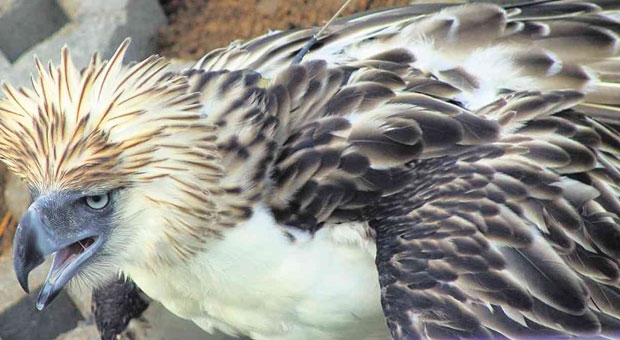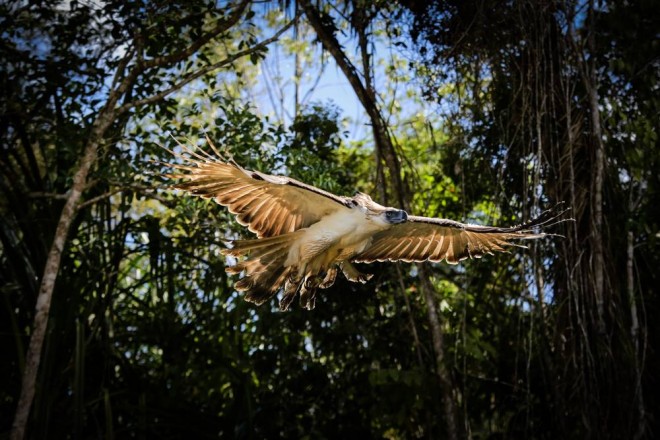The eagle has fallen; Pamana, 3, found dead
DAVAO CITY—Her freedom came with a price.
Pamana, the 3-year-old female Philippine eagle released inside a Unesco heritage site—Mt. Hamiguitan Range in San Isidro, Davao Oriental province—was found dead a kilometer away from where she took her flight to freedom on Independence Day, June 12.
Philippine Eagle Foundation (PEF) biologists and local forest guards found the eagle, already in an advanced state of decomposition, near a creek on Aug. 16.
In 2012, Pamana survived two bullet wounds in its left wing and left breast. After more than two years of rehabilitation, she was released into the wild. When found on Sunday, the eagle had a gun pellet hole in her right chest.
The PEF team had been monitoring the eagle by tracking radio signals from a miniature transmitter on her back. But around lunch time of Aug. 10, field workers noted that radio signals at their observation post were in “mortality” mode.
Mortality mode indicates that the transmitter has not moved for at least six hours, either the radio unit came off or the bird has died.
PEF team traced the location of the radio transmitter and found Pamana’s carcass near a creek below the thick forest. The eagle’s remains were in advanced state of decomposition, with maggot infestation.
Her blue leg band was still attached to her left leg, and her GPS and radio transmitters were still attached to her body.
Dr. Ana Lascano, the PEF veterinarian, found a 5-mm bullet hole on the bird’s right chest.
Lascano, in her necropsy report, said the bird could have suffered from “gunshot wound leading to possible trauma.”
Her time of death was estimated to be the morning of Aug. 10.
The Philippine eagle, one of the world’s largest birds of prey and is larger than the American bald eagle, was declared an endangered species in 1965. The Philippine eagle, locally known as “haribon,” stands at about one meter in height and has a wingspan of about two meters.
The Philippine eagle is endemic to the Philippines and is known to inhabit the forests in Luzon, Samar, Leyte and Mindanao. Only about 400 adult pairs remain in the country’s forests, where deforestation and poaching threaten their survival. More than half of them can be found in Mindanao.
Strong enforcement
“Pamana’s death underscores the need to strengthen our campaign to save not only the eagles but other wildlife in their natural habitats. Clearly, education and awareness aren’t enough. We need a strong law-enforcement program in place, especially in protected areas. Tama na ang (enough with) paper protection,” Dennis Salvador, PEF executive director, told the Inquirer.
The Philippine eagle is protected under Republic Act No. 9147, or the Wildlife Conservation and Protection Act. The law provides a penalty of imprisonment of between six and 12 years or a fine of between P100,000 and P1 million for the killing of critically endangered species.
In 2012, the Regional Trial Court of Malaybalay in Bukidnon province imposed a penalty amounting to P100,000 on a certain Bryan Bala-on after finding him guilty of killing and cooking a young male Philippine eagle.
Since it was declared by Unesco as a heritage site a year ago, the Mt. Hamiguitan Range has been closed to the public.
San Isidro Mayor Tina Yu, who learned about Pamana’s death on Wednesday morning, said the area was indeed “off limits to the public.”
“This is sad news for the people of San Isidro who, together with the PEF team, have closely monitored the daily situation of Pamana,” Yu told the Inquirer.
National bird
PEF has been trying to breed eagles in captivity to increase the bird’s population. Since 1992, it has successfully hatched 25 eaglets and the center has now 35 eagles, including those previously caught in the wild.
The center had its first eagle conceived, hatched and bred in captivity in Jan. 15, 1992. She was named Pag-asa.
The foundation, which depends heavily on donations for its project that includes breeding, education and campaign to save the endangered species, had released four eagles during the past two years, including Pamana.
In July 1995, President Fidel Ramos declared the Philippine eagle the national bird. At present, the species is classified “critically endangered” by the International Union for the Conservation of Nature.

NATIONAL TREASURE Pamana, a 3-year-old juvenile Philippine Eagle, died from a bullet wound on the chest two months after she was released into the wild on June 12. Pamana died on the Mount Hamiguitan Range, a Unesco World Heritage Site in Davao Oriental province. Famed for its elongated nape feathers that form into a shaggy crest, the country’s national bird is one of the world’s largest raptors, growing up to a meter (3.3 feet) long with a wingspan of two meters. IAN GARCIA/CONTRIBUTOR
Other fallen eagles
With two bullet wounds, Pamana was retrieved by the PEF team in Iligan City on Oct. 25, 2012. It was treated by Dr. Bayani Vandenbroeck and rehabilitated for two years at the Philippine Eagle Center in Malagos District here before it was released into the wild.
In July 2008, Kagsabua, a 3-year-old male juvenile Philippine Eagle, was killed and cooked by a 22-year-old indigenous farmer in Impasug-ong, Bukidnon.
Kagsabua was shot with an air gun while he was perched on a tree. Kagsabua is tribal word for unity. He was released into the wild on March 6, 2008.
Among those that failed to survive after having been released into the wild was Kabayan, who died more than a year after its release inside the Philippine National Oil Co. forest reserves in Ilomavis, Kidapawan City, on April 22, 2004. Kabayan was perching on a live wire.
He was the first captive-bred eagle released into the wild.–Joselle R. Badilla, Inquirer Mindanao; with Nico Alconaba, Inquirer Mindanao; and Inquirer Research
Originally posted as of 4:44 PM | Wednesday, August 19, 2015
RELATED STORIES
Released into wild, Philippine Eagle ‘Pamana’ shot dead
